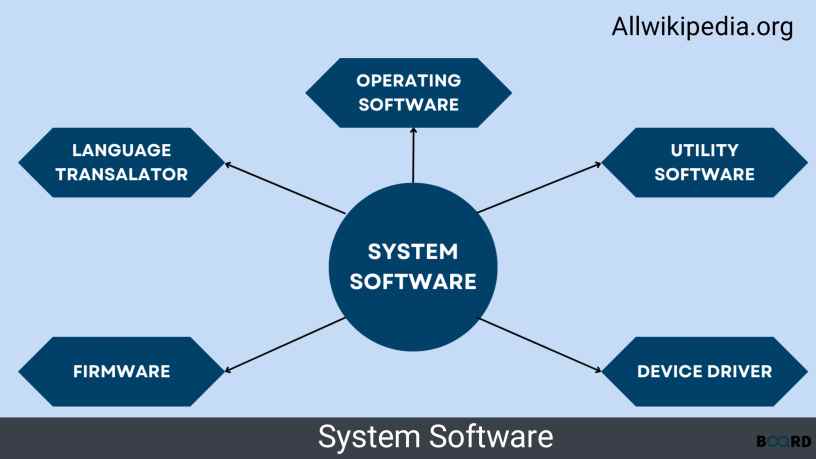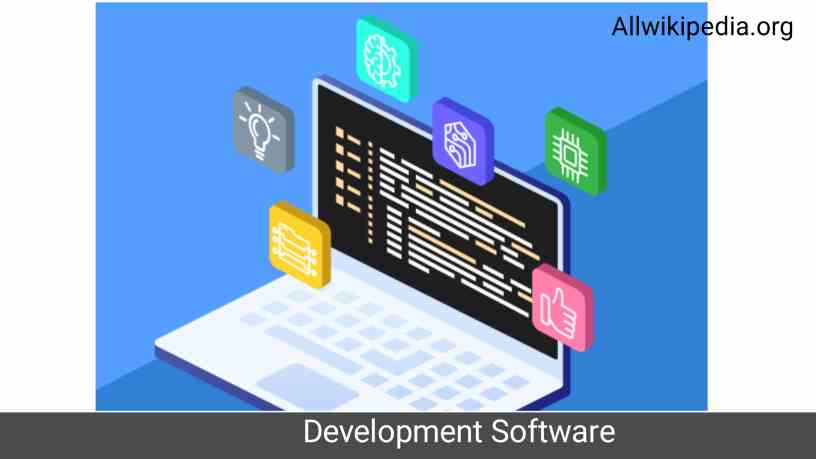In the article, What is Software and how it works, types of software have been explained.
What is Software । Software Definition
Software is a comprehensive term that encompasses all the digital instructions, programs, and data that enable a computer or digital device to perform specific functions. Unlike hardware, which refers to the physical components of a computer system, software is intangible and consists of a wide range of applications and systems that provide instructions for the hardware. This includes operating systems, which manage and coordinate hardware resources, as well as application software that performs tasks such as word processing, browsing the web, or playing games.
System software, such as operating systems (e.g., Windows, macOS, Linux), forms the foundation upon which other applications run. It manages hardware resources and provides a platform for running application software. Application software, on the other hand, is designed to help users perform specific tasks, from productivity applications like spreadsheets and word processors to entertainment software like games and media players.
Additionally, software includes development tools like compilers and integrated development environments (IDEs), which are used to create and maintain other software. Middleware, another category, acts as an intermediary between different software applications, facilitating communication and data exchange.
In essence, software transforms a computer’s hardware into a functional tool by providing the necessary instructions and data, enabling users to perform a vast array of tasks and operations.
How the Software works
Software operates through a sequence of steps that involve both code execution and interaction with hardware. At the heart of software is the code written in various programming languages. This code consists of a series of instructions that guide the computer’s processor (CPU) on what actions to perform. When a software application is launched, its code is either compiled into machine code, which is directly executed by the CPU, or interpreted line-by-line if it is an interpreted language.
The interaction between software and hardware is mediated by the operating system (OS), which manages and allocates system resources such as memory, processing power, and storage. The OS ensures that software applications can access the necessary hardware components, like the hard drive or network interfaces, through system calls and device drivers. These drivers are specific pieces of software that facilitate communication between the OS and hardware peripherals.
For user interactions, software often includes a graphical user interface (GUI) or a command-line interface (CLI). The GUI provides visual elements like buttons and menus that users can interact with, while the CLI allows for text-based commands. User inputs through these interfaces are translated into actions that the software processes according to its code. The results of these actions are then presented to the user or used to trigger further processes.
In essence, software functions by executing instructions encoded in programming languages, managing hardware through an operating system, and providing a user interface for interaction. This process transforms hardware capabilities into functional applications that meet user needs and perform a variety of tasks.
Types of Software
Software is categorized based on its functionality, purpose, and user interaction. Here’s a comprehensive overview of the main types of software:
1. System Software
System software provides the foundational support needed for hardware and application software to function effectively. It includes –

- Operating Systems (OS) -These manage the hardware resources of a computer and provide a user interface and services for application programs. Examples include:
- Windows – Developed by Microsoft, it is widely used for personal and business computers.
- macOS – Developed by Apple, it is used on Macintosh computers.
- Linux – An open-source OS used in various environments, from personal computers to servers.
- Utility Programs – These are designed for system maintenance and optimization. They help manage and control system performance and include:
- Antivirus Software – Protects against malware and security threats (e.g., Norton, McAfee).
- Disk Management Tools – Help in managing disk space, defragmentation, and backups (e.g., CCleaner, Disk Cleanup).
- Device Drivers – These enable the operating system to communicate with hardware components, such as printers, graphics cards, and network adapters. They act as intermediaries between the OS and hardware devices.
2. Application Software
Application software is designed to help users perform specific tasks. It includes –

- Productivity Software – Tools for creating, managing, and sharing documents, spreadsheets, and presentations. Key examples are:
- Microsoft Office – Includes Word, Excel, PowerPoint, and more.
- Google Workspace – Offers Docs, Sheets, Slides, and other productivity tools.
- Media Software – Programs used for creating, editing, and managing multimedia content. Examples include:
- Adobe Photoshop – For image editing and graphic design.
- Adobe Premiere Pro – For video editing.
- Web Browsers – Software for accessing and navigating the internet. Examples include:
- Google Chrome – Known for its speed and extensive extension support.
- Mozilla Firefox – Known for its privacy features and customizability.
- Games and Entertainment Software – Designed for leisure and entertainment purposes. This includes:
- Video Games – Both single-player and multiplayer games available on various platforms.
- Streaming Applications – Services for video and music streaming (e.g., Netflix, Spotify).
- Educational Software – Tools aimed at enhancing learning and education. Examples include:
- Duolingo – For language learning.
- Khan Academy – Provides educational resources and tutorials.
3. Development Software
Development software aids in creating, testing, and maintaining other software applications. It includes –

- Programming Languages – These are used to write code that powers applications. Examples include:
- Python – Known for its simplicity and versatility.
- Java – Widely used in enterprise environments and Android app development.
- Integrated Development Environments (IDEs) – Platforms that provide comprehensive tools for coding, debugging, and testing software. Examples include:
- Visual Studio – Offers a rich environment for developing applications, particularly in .NET.
- Eclipse – Popular for Java development and other programming languages.
- Compilers and Interpreters – Tools that convert code written in high-level programming languages into machine code. Compilers do this all at once, while interpreters do it line-by-line.
- Version Control Systems – Manage changes to source code over time. Examples include:
- Git – Widely used for tracking changes and collaborative development.
- Subversion (SVN) -A version control system for managing project changes.
4. Middleware
Middleware facilitates communication and integration between different software applications and systems. It includes –

- Database Management Systems (DBMS) – Manage and interact with databases. Examples include:
- MySQL – An open-source relational database management system.
- Oracle Database – Known for its robust performance and scalability.
- Web Servers – Manage and serve web content to users. Examples include:
- Apache HTTP Server – An open-source web server known for its flexibility.
- Nginx – Known for its performance and scalability in serving high-traffic sites.
- Application Servers – Provide a platform for running and managing web applications. Examples include:
- JBoss – An open-source application server.
- IBM WebSphere – A comprehensive application server platform.
5. Firmware
Firmware is specialized software embedded in hardware devices to control their functions. It is essential for the operation of many types of hardware. Examples include

- BIOS/UEFI – Firmware that initializes hardware during the boot process of a computer and provides runtime services.
- Router Firmware: Controls the operations of network routers and modems.
6. Embedded Software
Embedded software is designed to run on specific hardware systems within larger devices. It is tailored for specialized functions and is integral to many consumer and industrial products. Examples include –

- Automotive Systems – Software that controls vehicle functions, such as engine management and navigation systems.
- Consumer Electronics – Software in devices like smart TVs, washing machines, and wearable devices.
In summary, software encompasses a broad range of applications and tools, each serving different purposes—from managing hardware and enabling user tasks to facilitating software development and ensuring integration between systems. Each type plays a crucial role in the functionality and efficiency of modern computing environments.
History of Software
The history of software traces back to the early days of computing and reflects the evolution of technology and programming practices. Initially, software was synonymous with hardware in early computing machines. The first software, in the form of simple machine code, was directly programmed into early computers like the ENIAC and UNIVAC. These early programs were written in binary and were manually entered into the machines using punch cards or paper tape.
As technology advanced, the concept of software began to separate from hardware. In the 1950s and 1960s, the development of assembly languages made programming more accessible by using symbolic instructions rather than binary code. This period also saw the creation of early high-level programming languages such as Fortran (1957) and COBOL (1959), which allowed programmers to write more complex and human-readable code. The advent of these languages marked a significant shift towards more abstract and efficient programming practices.
The 1970s and 1980s brought further advancements with the introduction of operating systems like UNIX and early personal computers, such as the Apple II and IBM PC. This era saw the rise of software development practices and tools, including compilers, text editors, and integrated development environments (IDEs). The software industry began to grow rapidly, driven by the increasing demand for business and personal applications.
The 1990s witnessed the explosion of the internet and the World Wide Web, which revolutionized software distribution and development. The introduction of graphical user interfaces (GUIs) in operating systems like Windows 95 and the rise of web browsers transformed how users interacted with software. Open-source software emerged as a significant movement, with projects like Linux demonstrating the potential of collaborative development.
Entering the 21st century, software has become an integral part of everyday life, with advancements in mobile computing, cloud services, and artificial intelligence. Modern software development practices emphasize agility, continuous integration, and user-centric design. The proliferation of apps, SaaS (Software as a Service) platforms, and advanced technologies like machine learning and blockchain has further expanded the scope and impact of software across various domains.
I Am J.P Meena From Guna, MP (India) I Owner of Allwikipedia.org Blog. World class information on Technology & Science is researched and brought to you on allWikipedia.org